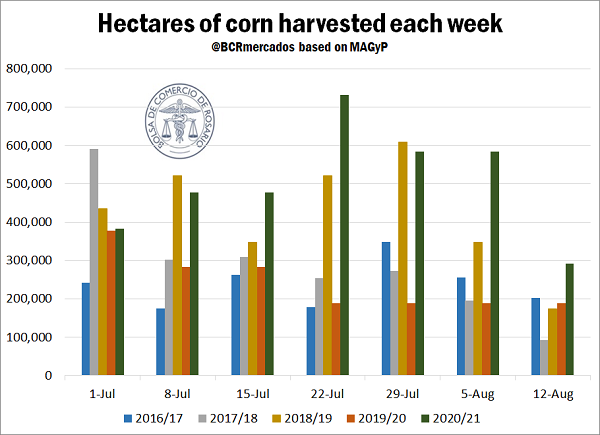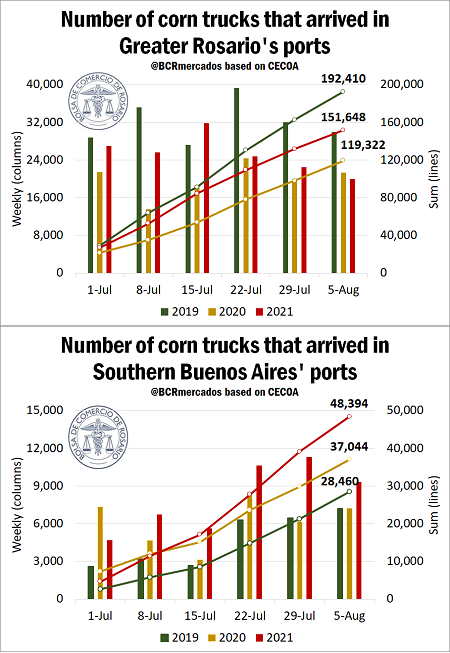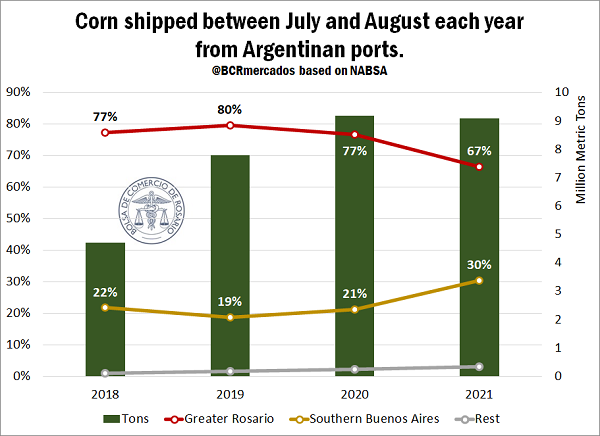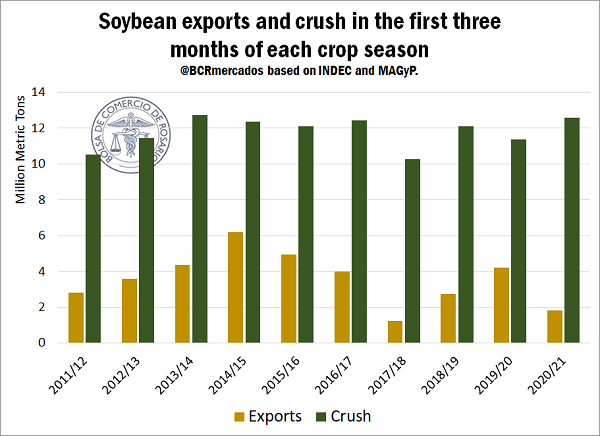Sharp increase in arrival of trucks due to late corn entry
The harvest of corn progressed firmly during last month and is virtually finalized, with only 2% of the area still to be harvested on a national level. Just as it was mentioned in previous editions, during the current crop season a great share of the total area was planted with late corn. As a result, a high number of hectares were harvested between early July and early August. The hectares harvested per week during July and August in the last five crop seasons can be appreciated in the following graphic. As can be seen, the number of hectares harvested per week since beginnings of July 2021 has been high, emerging above the record of the previous years in several weeks, particularly since mid-month to date. Besides, during that period, 3.5 total hectares were harvested, about 39% of the total area.
This high area of corn harvested during last month has led to a sharp increase in the number of trucks that arrived in the ports of the country. As a matter of fact, since beginnings of July of the current year to date, 151,648 trucks entered the ports of Rosario hub, which marks a 27% increase with regards to the same period in 2020, while the ports in the South of Buenos Aires province received 48,394 trucks, 31% more than last year.
Furthermore, the severely low water level of the Paraná River is causing logistic problems in the load of vessels in the Up River Ports, reason why a high share of load must be relocated to the ports in the South of Buenos Aires. As can be seen in the following graphic showing the entry of trucks with corn in both port areas since the beginnings of July to date, during 2021 the unload in the ports of Bahía Blanca and Necochea/Quequén has grown considerably, exceeding the records of previous years. In Rosario hub, however, the number of trucks entered is above the record of 2020 but below the number of 2019.
Also, this increase in the number of trucks with corn that arrived in the ports in the South of Buenos Aires also matches the number of shipments. During the months of July and August of the current year, the total tons of corn shipped and scheduled to be shipped from Argentinian ports rises to 9.1 Mt, of which 67% have as origin the ports of Rosario hub, while 30% have as origin the ports of Bahía Blanca and Necochea/Quequén. This is the lowest relative importance of the Up-River Paraná Ports (and, in parallel, the highest share of the ones in the South of Buenos Aires) at least since 2018.
As for soybean, there are two interesting phenomena to analyse that are related to one another. On the one hand, soybean exports during the first three months of the crop season reach 1.8 Mt, that is to say, 56% less than during the first trimester of the previous crop. Besides, it is the second lowest volume of the last decade, only exceeded by what happened during crop season 2017/18, when a fateful historical draught severely affected production. On the other hand, soybean crush during the first 3 months of crop season 2020/21 totals 12.6 Mt, 10% above the first three months of the previous crop and registering the second best figure in the last decade.
This is mainly due to the increase in prices of soybean oil. Vegetable oils have experienced a phenomenal upward rally during the last 12 months, including soybean oil. The rise in prices has improved the oil share in the total value, encouraging a higher share of local processing of the soybean for its later export of the by-products, at the expense of exports of the unprocessed soybean. As a matter of fact, soybean meal exports between April and June total 8.45 Mt, a 17% increase with regards to crop season 2019/20, and the highest volume in six years, while soybean oil exports during the first trimester of the crop season reach 1.83 Mt, the best record in history.



